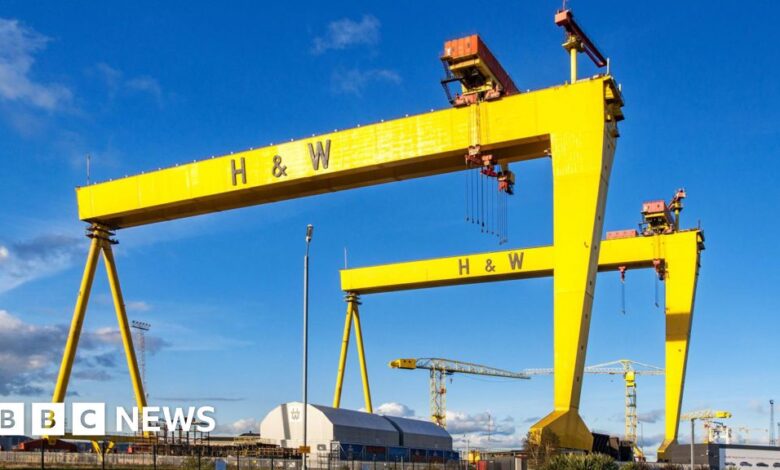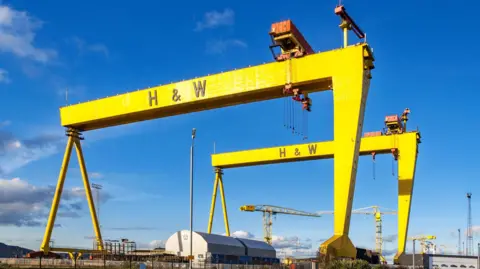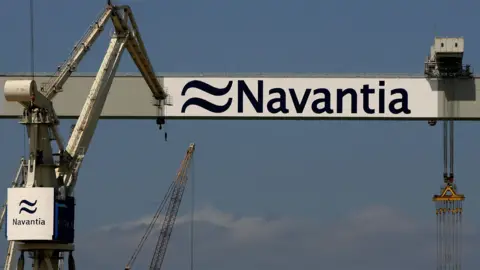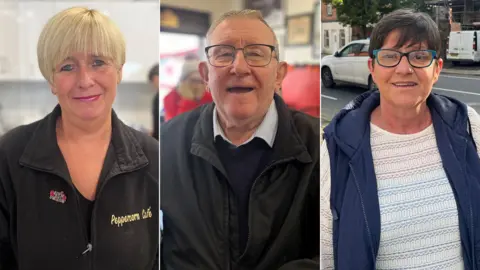Harland & Wolff: Spanish shipbuilder Navantia saves Belfast shipyard

 Getty Images
Getty ImagesHarland & Wolff, the Belfast shipyard best known for the Titanic, has been saved by a deal with Spain’s state-owned shipbuilder.
Navantia had been in exclusive negotiations since October after Harland & Wolff’s holding company fell into administration.
About 1,000 jobs are to be saved in the deal, which also includes Harland & Wolff’s facilities in Scotland and England.
The UK Business Secretary Jonathan Reynolds said the deal was “good for jobs” and “good for national security”.
 Reuters
Reuters‘The devil will be in the detail’
Reynolds said that the deal secures all four Harland & Wolff yards across the UK and guarantees jobs for “years not months in all four of those yards”.
He added that the deal was “a major vote of confidence in the UK from Navantia”.
Asked whether the government had sweetened the deal for Navantia by changing the terms of a contract to deliver three Royal Navy support ships, Reynolds said there had been a “minor revision” to the contract to include “more support” from the government.
The deal is to be presented as early fruits of the government’s post Brexit “reset”.
Gavin Robinson, the leader of the Democratic Unionist Party (DUP), said he was “delighted that this agreement has been reached which will secure the future of jobs in Belfast and in its other sites”.
The MP for East Belfast said that uncertainty over the future of the business had been “hugely unsettling… particularly for all the staff at the yard”.
Robinson added that Harland & Wolff “forms part of a wider defence sector that has huge potential for further growth in Northern Ireland”.
George Brash, Unite the union’s regional officer for the shipyard workers in Belfast, told BBC News NI that it was a “hugely positive move”, but that “the devil will be in the detail”.
He said Unite would now engage with the deal and work to ensure the delivery of guarantees both for jobs and continuity of employment.
 Getty Images
Getty ImagesNavantia, which is 100% owned by Spain’s government, has been a significant recipient of funding from the European Commission as part of the European Defence Fund.
Joining the fund is a possible objective for the UK-EU security reset, set to be discussed at a summit early in the new year.
The Spanish economy minister responsible for its state-owned businesses, Carlos Cuerpo, met with Chancellor Rachel Reeves and Business Secretary Jonathan Reynolds in London last month.
Navantia already has a business relationship with Harland & Wolff. It is the main contractor on a project to build three support ships for the Royal Navy, with Harland & Wolff acting as UK subcontractor.
The company employs a core staff of about 1,000 in Belfast, Appledore in England and Methil and Arnish in Scotland.
Navantia’s main shipyard is at Cadiz in southern Spain.
It employs more than 4,000 people and has an annual turnover of about €1.3bn (£835m).

What does Harland & Wolff mean to east Belfast?

For people in Belfast, particularly the east of the city where the yellow cranes, Samson and Goliath, cast their shadows, this takeover will be good news.
Café worker Anne Higgins’ family members worked in the Harland & Wolff shipyard in east Belfast.
“It’s very iconic for Belfast,” she told BBC News NI.
Harry Fisher worked in the shipyard in the 1960s.
“It means everything to this side of the city,” he said.
“If it ever folds, I don’t know what the people of east Belfast would do. The two cranes will be there forever.”
He recalled “thousands of men walking down his street” to get to the shipyard in the morning for work.
Joanne Watton told BBC News NI that the cranes are such a “beautiful sight”.
“When you’re on a plane and see the cranes, you know you’re home.”
Analysis: Probably the best result for Harland & Wolff
For some people, a takeover by Spain’s national shipbuilder will represent another example of the UK’s industrial decline.
For the Harland & Wolff workforce, it is probably the best possible result.
In 2019, the company’s Norwegian owner decided the shipyard didn’t have a future and it was placed into administration.
It was then bought by a UK company which had ambition but lacked money and expertise.
Now it is heading into the ownership of an established shipbuilder which has the financial backing of the Spanish state.
What is the history of Harland & Wolff?
Harland & Wolff was founded in 1861 by Yorkshireman Edward Harland and his German business partner, Gustav Wolff.
By the early 20th Century, Harland & Wolff dominated global shipbuilding and had become the most prolific builder of ocean liners in the world.
However, in the period since World War Two it has lurched from crisis to crisis and was under UK state control from 1977 to 1989.
In 2019, its then Norwegian owners withdrew financial support and the business fell into insolvency, having not built a ship in a generation.
 Getty Images
Getty ImagesIt was bought by InfraStrata, a small London-based energy firm which did not have significant experience in marine engineering.
InfraStrata later changed its name to Harland & Wolff and in 2022 won the Royal Navy contract as part of a consortium led by Navantia.
However, financial losses mounted as it scaled up its operations and it became increasingly reliant on high-interest borrowings from a specialist US lender, Riverstone.
The company sought a £200m government loan guarantee to refinance its borrowings but that was rejected for being too risky for taxpayers.
Its holding company entered administration in September and restructuring expert Russell Downs was appointed to run the business and find a new owner.





